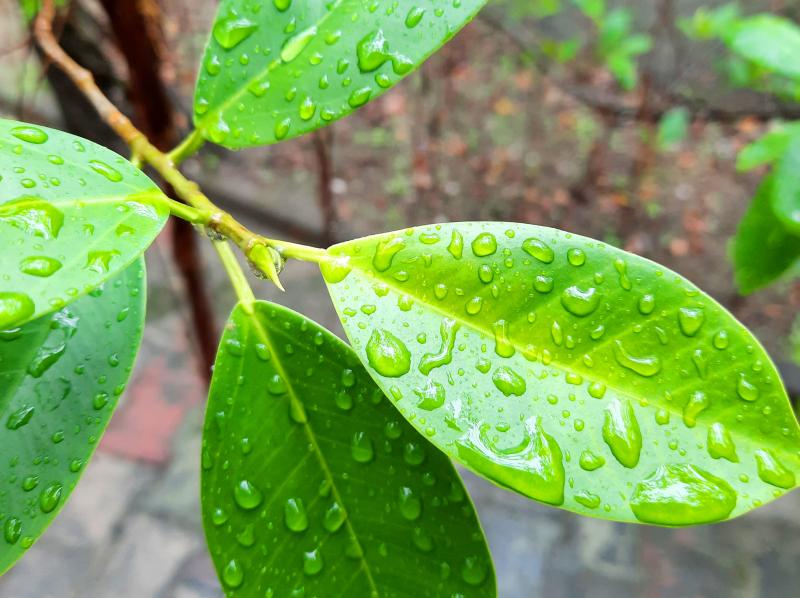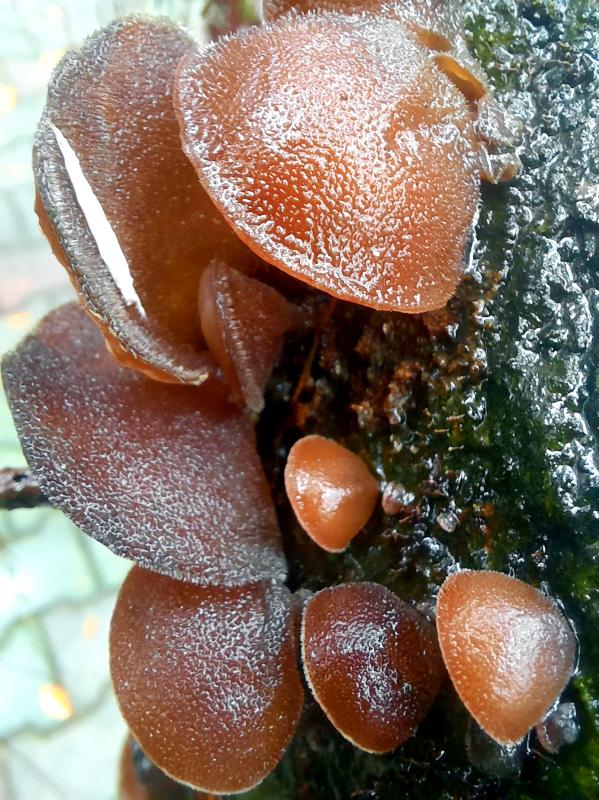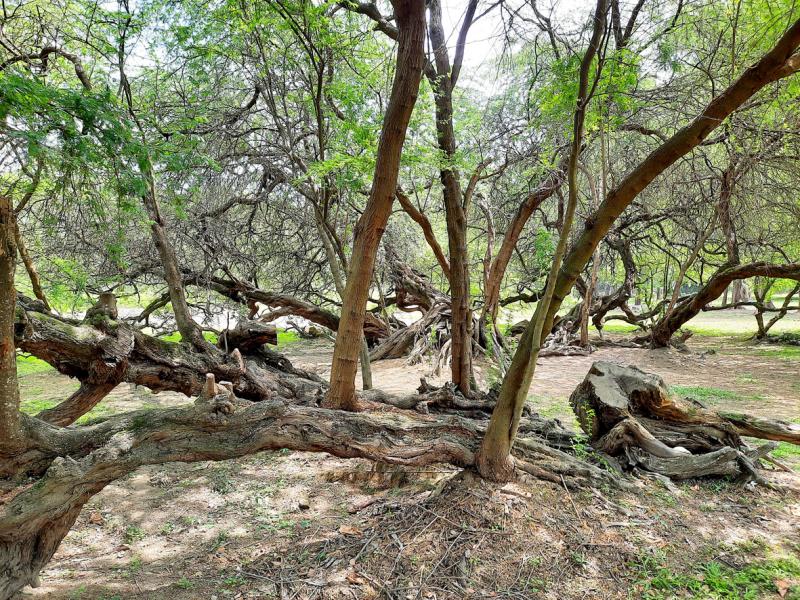Tainan is a place of ancient buildings, old traditions and distinguished trees. Some of these living landmarks outstayed seven Qing emperors and the Japanese colonial government that ruled Taiwan from 1895 to 1945, then survived the country’s breakneck modernization following World War II.
In 2012, the Tainan City Government created a legal framework for the protection of precious old trees. Details of 271 evergreen and deciduous trees so far registered can be found at: oldtree.tainan.gov.tw (Chinese only). This database, maintained by the city government’s Agriculture Bureau, is an excellent resource for tree aficionados planning sightseeing trips around the municipality.
Few of these trees are in forests. Several are beside roads, or on school campuses. Many of them belong to temples, but others lack clear ownership. At each, the Agriculture Bureau has installed a noticeboard with basic information.

Photo: Steven Crook
‘PRECIOUS NATURAL RESOURCE’
The Web site says Tainan’s old trees “are not only a precious natural resource, but also a crystallization of local heritage. They provide us with shade and shelter from rain, while carrying precious memories. The only thing we can do to repay them is protect these green gems that shine with life and history.”
Some of the trees have suffered prolonged mistreatment. According to the profile of tree no. 150, a Chinese banyan (榕, Ficus microcarpa) just west of Jinsha Elementary School (金砂國小) in Sigang District (西港), it has been repeatedly hacked at so it doesn’t interfere with utility lines. Crude pruning has left it “obviously skewed to one side.” What’s more, its trunk shows signs of disease, pests and rotting, and many of its branches are dead.

Photo: Steven Crook
Like other official old trees, that banyan now enjoys municipal protection. Landowners and users are not allowed to cut trunks, branches or roots, dig, or pollute or compact the soil. Nor are they allowed to obstruct personnel sent to survey or conserve the trees. And if they find that a protected tree has been damaged (by a typhoon, for instance) or is suffering from disease or infestation, they must immediately report it to the authorities. Breaching these rules may result in a fine of up to NT$100,000.
These protections aren’t absolute, however. When drawing up the regulations, the city government reserved powers to decide if a construction project will benefit the public more than the preservation of an old tree that stands in the way. In such cases, transplanting the tree is one solution.
The authorities relocated tree no. 164 in Sinying District (新營) for a different reason, however. Development of adjacent land had left this Chinese banyan in a spot prone to inundation.

Photo: Steven Crook
It’s said that all efforts to trim it in decades past had failed — chainsaws applied to its branches would break almost immediately — so officials first sought approval from the principal deity of the shrine which owns the tree. After praying to Emperor Kaitianyan (開天炎帝) in Jhenan Temple (鎮安殿), it was determined that June 13, 2019 was an auspicious day to begin the transfer. Tree no. 164 is now in a nearby park.
UNUSUAL TREE SPECIES
Chinese banyans (also known as marabutan) account for more than 40 percent of Tainan’s officially-recognized old trees. Among the exceptions are certain species not often seen in this country.

Photo: Steven Crook
At Sankandian (三崁店) in Yongkang District (永康) — very near the ruins of a Shinto shrine erected during the 1895-1945 period of Japanese colonial rule (see “Traces of Shintoism in eastern and southern Taiwan” in the Apr. 22 issue of this newspaper) — there’s a 95-year-old Prosopis juliflora specimen, no. 209 on the Old Tree database.
This type of tree doesn’t grow especially tall or broad, but when allowed to, like here, it can easily spread out and shade an area bigger than that of a tennis court.
As its Chinese name (Mexican acacia, 墨西哥合歡) suggests, Prosopis juliflora is native to countries around the Caribbean. Its wood is unusually hard and also a sought-after fuel. In Africa, however, it’s considered an invasive nuisance, because it provides malaria-spreading mosquitoes with the plant sugars they need to survive dry spells.
More than a dozen of Tainan’s listed “old trees” are camphor (樟, Cinnamomum camphora). Others are bishopwood (茄苳, Bischofia javanica) or Madras thorn (金龜, Pithecellobium dulce).
Among Tainan’s more notable mango (芒果, Mangifera indica) trees is no. 256 on the Agriculture Bureau’s list.
It’s in an easy-to-reach neighborhood in central Sinying, yet currently hidden from sight as the surrounding colonial-era dormitory buildings undergo renovation. Despite the disruption, the tree — now close to a century old — still bears fruit.
Trees that aren’t at least 80 years old, or lack the rarity value of Sankandian’s Prosopis juliflora, must meet certain height, breadth or canopy-size requirements.
Trees nos. 137 and 138, in the little village of Bensie (本協) in Houbi District, satisfy the age and physical-dimensions criteria with ease. These mighty banyans are believed to date from just after the arrival of Cheng Cheng-kung (鄭成功, or Koxinga), the Ming loyalist whose army defeated the Dutch and established the Kingdom of Tungning (東寧王國) in 1662.
Some of no. 137’s branches are supported by steel buttresses, but the confidence with which locals loiter nearby, or sit on the benches that it shades, suggests they’re not expecting the tree to collapse anytime soon.
Several of Bensie’s houses are well-preserved examples of vernacular architecture, built using materials such as bamboo and mudbricks. Chaotian Temple (朝天宮), in the southeastern corner of the settlement, has two unlisted yet impressive banyans, and — smack in the middle of the road — a sealed-up well.
Dendrophiles should approach the community via Road 172A (172甲), which has a delightfully complete “green tunnel” consisting of Andaman redwoods (印度紫檀, Pterocarpus indicus).
BIG TREES
The Old Tree Web site doesn’t make it clear which of Tainan’s trees is the largest, but a strong candidate can be found in Shiherdian (十二佃) in Annan District (安南).
Shiherdian (“Twelve Tenants”) gets its name from the 12 families that settled here in the mid-19th century to convert flood-prone marginal land into rice fields.
According to local historians, the pioneers planted a Chinese banyan (no. 266 on the Old Tree list) because of a folk belief that such trees are able to tame waterways. Until it was confined between levees, the Tsengwen River (曾文溪), 2.2km to the northwest, had a reputation for breaking its banks.
The banyan’s canopy now exceeds 3,000 pings (坪), or about one hectare. It completely encircles Wusheng Temple (武聖廟), and gives the place a special atmosphere.
Some visitors find the tree’s sprawl and chaotic drooping quite unsettling. Not me. When I was last here, on a wet spring day, I just wondered: How big would it be now, if it’d been allowed to expand naturally?
Steven Crook has been writing about travel, culture and business in Taiwan since 1996. He is the author of Taiwan: The Bradt Travel Guide and co-author of A Culinary History of Taipei: Beyond Pork and Ponlai.

The Directorate-General of Budget, Accounting and Statistics (DGBAS) told legislators last week that because the Chinese Nationalist Party (KMT) and Taiwan People’s Party (TPP) are continuing to block next year’s budget from passing, the nation could lose 1.5 percent of its GDP growth next year. According to the DGBAS report, officials presented to the legislature, the 2026 budget proposal includes NT$299.2 billion in funding for new projects and funding increases for various government functions. This funding only becomes available when the legislature approves it. The DGBAS estimates that every NT$10 billion in government money not spent shaves 0.05 percent off

It is a soulful folk song, filled with feeling and history: A love-stricken young man tells God about his hopes and dreams of happiness. Generations of Uighurs, the Turkic ethnic minority in China’s Xinjiang region, have played it at parties and weddings. But today, if they download it, play it or share it online, they risk ending up in prison. Besh pede, a popular Uighur folk ballad, is among dozens of Uighur-language songs that have been deemed “problematic” by Xinjiang authorities, according to a recording of a meeting held by police and other local officials in the historic city of Kashgar in

Dec. 29 to Jan. 4 Like the Taoist Baode Temple (保德宮) featured in last week’s column, there’s little at first glance to suggest that Taipei’s Independence Presbyterian Church in Xinbeitou (自立長老會新北投教會) has Indigenous roots. One hint is a small sign on the facade reading “Ketagalan Presbyterian Mission Association” — Ketagalan being an collective term for the Pingpu (plains Indigenous) groups who once inhabited much of northern Taiwan. Inside, a display on the back wall introduces the congregation’s founder Pan Shui-tu (潘水土), a member of the Pingpu settlement of Kipatauw, and provides information about the Ketagalan and their early involvement with Christianity. Most

The People’s Republic of China (PRC) was out in force in the Taiwan Strait this week, threatening Taiwan with live-fire exercises, aircraft incursions and tedious claims to ownership. The reaction to the PRC’s blockade and decapitation strike exercises offer numerous lessons, if only we are willing to be taught. Reading the commentary on PRC behavior is like reading Bible interpretation across a range of Christian denominations: the text is recast to mean what the interpreter wants it to mean. Many PRC believers contended that the drills, obviously scheduled in advance, were aimed at the recent arms offer to Taiwan by the